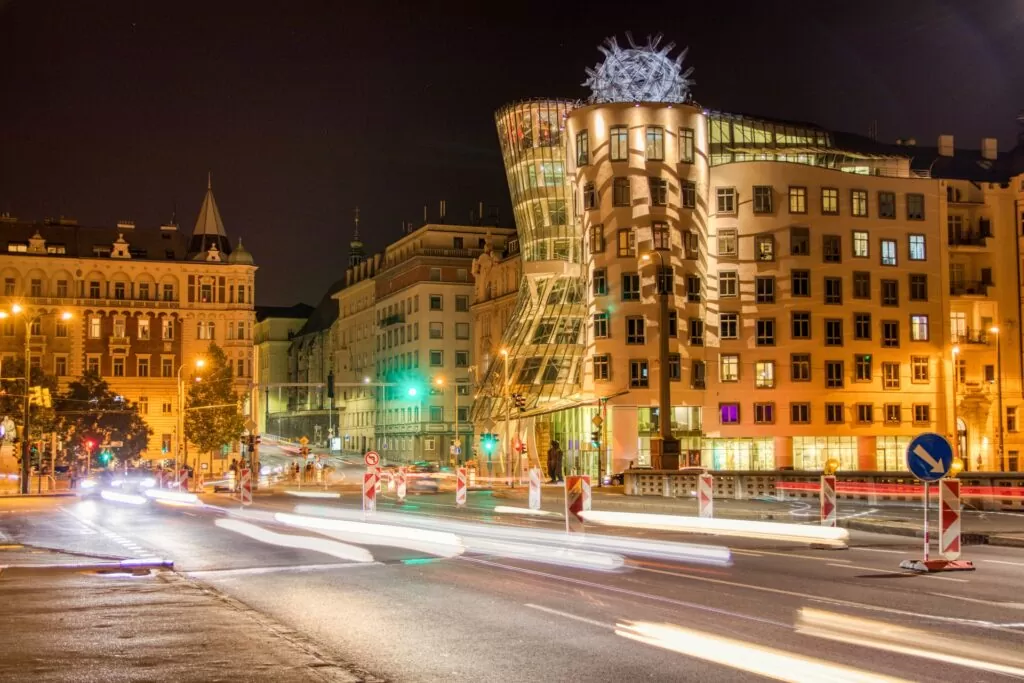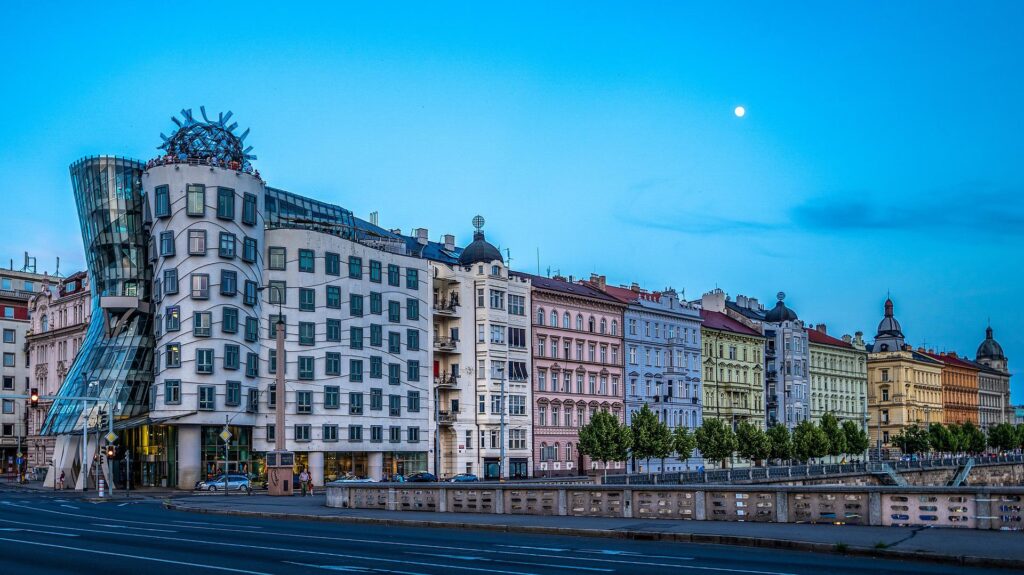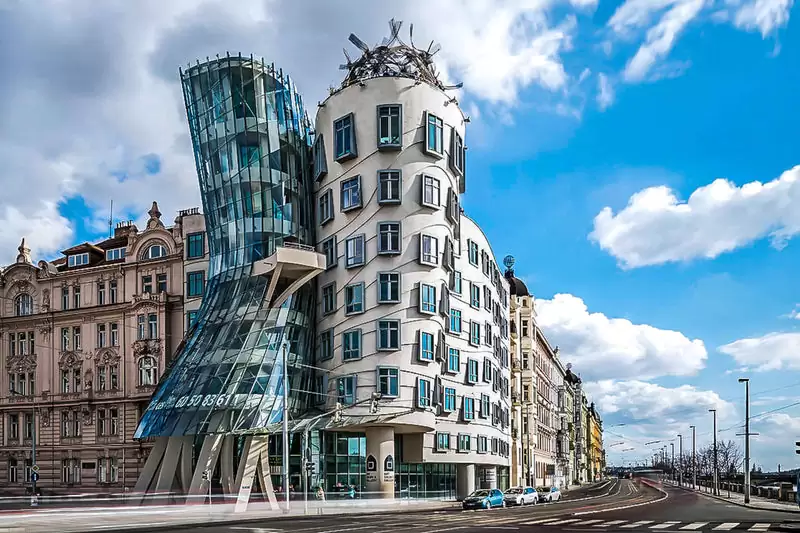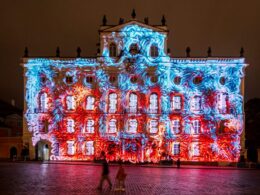Table of contents Show
Czech name: Tančící Dům
The Czech Republic’s capital city is packed with interesting places to see, especially from the city’s rich historical past. However, there are many interesting new attractions to see. The Prague Dancing House is one such structure, seamlessly blending parts static and dynamic elements. The building’s original idea was inspired by the dance of the legendary on-screen couple Fred Astaire and Ginger Rogers, and has a striking resemblance to both of them. It was designed to symbolize the transition of Czechoslovakia from a communist regime to a parliamentary democracy, encapsulating ten centuries of architectural evolution within its unique and contemporary design.
A controversial symbol of the post-communist Czech Republic, Tančící dům in Prague — aka the Dancing House in Prague — is one of the world’s most celebrated buildings and a popular Prague landmark. Also known as Prague Ginger and Fred building, the ultra-modern, nine-story structure is a surrealist painting come to life that was bankrolled by finance conglomerate Nationale-Nederlanden, designed by the superstar architectural team of Milunić-Gehry, and widely considered the best example of modern architecture in Prague.
This unusual shape building has become a symbol of the city. It is situated close to the building of the Czech National Bank, an impressive structure that has stood for over 10 centuries and is an integral part of the city’s extensive architectural history and legacy. Built in 1996, the it is also known as the Nationale-Nederlanden building. The building’s unique shape is said to emulate two dancers, with one figure representing a man and the other a woman.
What is the Dancing House in Prague used for?
In addition to offices, the Frank Gehry House holds an art gallery, 21-room boutique hotel, restaurant, and bar. Are you on a strict budget? Head straight to the observation deck and enjoy a free-but-breathtaking view of Prague.
Overview of the Dancing House Origin
It is a well-known piece of deconstructivist architecture in Prague, Czech Republic. It can be seen on the Ran Embankment. This building started going up in 1992 and was completed in 1996.
Architects Frank Gehry and Vlado Miluni designed the structure. The building’s distinctive undulating form has earned it the moniker “Fred and Ginger,” after the renowned dancing duo Fred Astaire and Ginger Rogers. There are office spaces, a high-end hotel, and an eatery named Ginger & Fred’s on the structure’s nine above-ground stories.
Building it in 1996 was a statement in and of itself, especially in comparison to the rest of the neighbourhood, which was dominated by cookie-cutter ‘art nouveau structures. The Dancing House is well-known among sightseers because of the rooftop restaurant it contains, which provides breathtaking panoramas of the city below.
History of the Prague Dancing House

The Dancing House’s unusual origins can be traced back to the end of the Second World War when American aviation began a horrible attack against the capital, killing 700 people and destroying almost 200 buildings in under 5 minutes. A grand mansion previously occupied the location of the Dancing House.
The 1945 U.S. bombing of Prague destroyed a building where the Frank Gehry Dancing House now stands. The lot laid vacant for decades until dissident-turned-president Václav Havel and architect Vlado Milunić revived an idea the pair first contemplated in the 1980s: refreshing the bombed-out space with a modern building that served as a culture center.
Protests against the government escalated after the collapse of the Wall of Berlin when Václav Hável peacefully toppled the Czechoslovak Communist Party and set up a federal-style republic known as the Velvet Revolution.
Havel became the leader of the new state after a nationwide strike immobilized the nation and toppled the previous government. Hável once again considered redeveloping that neglected plot of land, and he ultimately settled on architect Milunići to oversee the endeavor.
With the help of its local representative and Milunić’s acquaintance, Pavel Koch, the Company Nationale Nederlanden (now known as ING Group) acquired the property and became a sponsor for the project. His plan was to construct an iconic structure in Prague to serve as their headquarters. Moreover, plans for the cultural center were scrapped and replaced with commercial concerns. Ultimately, Vlado Milunić recruited Frank Gehry to co-lead the endeavor — and the rest, as they say, is history. Plans started in 1992, and it was completed in 1996.
Gehry, the Dancing House architect, originally called the building “Fred and Ginger,” after the famous dancers Fred Astaire and Ginger Rogers. The glass portion was meant to represent Ginger and the concrete part Fred. But after some consideration, Gehry abandoned the idea, realizing it was distasteful to “import American Hollywood kitsch to Prague.”
The Dancing house’s Decor
Deconstructivist architecture, which is used in the Dancing House, is a form of postmodernism that celebrates dissonance. Deconstructivism, also referred to as new baroque, resulted in architecture that seemed “deconstructed” and disjointed. The phrase was coined to indicate a rejection of the Russian Constructivist ideology. Harmony, clear forms, and consistent textures are all things that should be avoided in deconstructivist design.
As you delve into the intricate details of the Dancing House’s façade, you’ll find yourself pondering the larger narrative of architectural history. The interplay of materials, textures, and spatial arrangements embodies the essence of architectural discourse that has spanned ten centuries.
Five Distinct Features of the “Dancing House”

Among the predominantly art nouveau, baroque, and classical architecture of Prague is the unusually designed Dancing House. A short list of the Dancing House’s more prominent structural features follows.
- First, the glass windows stick out from the building’s exterior. The structure’s concrete facade features a random arrangement of windows. The window frames stick out from the facade, giving the building a more three-dimensional appearance.
- it symbolizes yin and yang. The undulating pillar stands for the still figure, while the swooping glass tower portrays the dancers.
- There are stunning vistas. The Ginger & Fred eatery, a high-end hotel, and a bar may all be found within one structure Sight of the Charles Bridge, the river Vltava, and Prague Castle may be seen from the restaurant.
- A metal tuft is attached to a particular pillar. A sculpture called “Medusa” is perched atop the building, composed of twisted metal tubes and wire mesh. It was installed at the time of the building’s dedication.
- The building was primarily made of steel, glass, and concrete. Two central pillars support the structure; one is constructed of glass and steel, while the other is solid concrete. In addition, ninety-nine cement panels of varying sizes and forms were fabricated to help maintain the pillar’s out-of-the-ordinary form.
Location of the Frank Gehry Dancing House in Prague & How to Get There
A standout gem of New Town district, the Dancing building in Prague sits on the Rašín Embankment (Rašínovo nábřeží) in Jirásek Square (Jiráskovo náměstí).
What public transportation options drop you near the Frank Gehry House? By metro, take the B line to Karlovo Náměstí Station; Fred and Ginger is about a three-minute walk from there. By tram, hop on the 17 and get off at Jiráskovo náměstí; the Dancing building is about 290 feet away from the stop. Alternatively, you can take a 907 city bus and alight at the Karlovo náměstí terminal, which is about four minutes away from the destination. Want to sneak in some exercise? It’s a lovely 20-minute walk from Old Town to the Dancing House by Frank Gehry.
Opening Hours & Czech Republic Dancing House Tickets
The building is open daily from 10 a.m. to 10 p.m., and it’s free to enter. Ginger & Fred, the 7th-floor restaurant, is open from 11 a.m. to midnight every day. The Glass Bar, on the 8th floor, is open Monday through Sunday from 10 a.m. to midnight.
What to Do & What to See at the Frank Gehry House
The Dancing House — designed by a Croatian-Czech architect Vlado Milunić and a Canadian-American architect Frank Gehry — is one of the world’s most famous buildings. The deconstructivist marvel has won several prestigious awards and the inside, designed by renowned Czech architect Eva Jiřičná, is as mind-bending as the outside. Ninety-nine differently-sized concrete panels give the building its wavy, bendy shape, affecting the interior rooms and hallways. Walking around the Frank Gehry Dancing House is like walking into an M.C. Escher painting!
What makes the Dancing House in Prague exciting is its perspective-warping shape. Its two towers — one glass and the other rock — look like giant sculptures. Symbolically, the two sections represent both static and dynamic energy meant to honor Czechoslovakia’s transition from a communist state to parliamentary democracy.
Like many postmodern buildings planted around the globe, the Frank Gehry House is a hotbed of controversy. Detractors feel its attention-grabbing style has no place sitting aside the Baroque, Gothic, and Art Nouveau buildings that otherwise line the city’s streets. Proponents, on the other hand, appreciate its modern flair.
Visit this masterpiece the next time you’re in Prague if you have any interest in design, art, architecture, photography, or are simply a visual person in general.
The Dancing House is a must-see not only because of its unique view over the Vltava River and Prague Castle but also because it is an identifiable gem of postmodern architecture in Prague.





